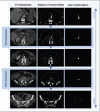Manufacturing flexible vascular models for cardiovascular surgery planning and endovascular procedure simulations: An approach to segmentation and post-processing with open-source software and end-user 3D printers
- PMID: 37065673
- PMCID: PMC10090811
- DOI: 10.18063/ijb.v9i2.669
Manufacturing flexible vascular models for cardiovascular surgery planning and endovascular procedure simulations: An approach to segmentation and post-processing with open-source software and end-user 3D printers
Abstract
306Three-dimensional (3D)-printed vascular models for cardiovascular surgery planning and endovascular procedure simulations often lack realistic biological tissues mimicking material properties, including flexibility or transparency, or both. Transparent silicone or silicone-like vascular models were not available for end-user 3D printers and had to be fabricated using complex and cost-intensive workarounds. This limitation has now been overcome by novel liquid resins with biological tissue properties. These new materials enable simple and low-cost fabrication of transparent and flexible vascular models using end-user stereolithography 3D printers and are promising technological advances toward more realistic patient-specific, radiation-free procedure simulations and planning in cardiovascular surgery and interventional radiology. This paper presents our patient-specific manufacturing process of fabricating transparent and flexible vascular models using freely available open-source software for segmentation and 3D post-processing, aiming to facilitate the integration of 3D printing into clinical care.
Keywords: 3D printing; Biological tissue; Endovascular simulation; Flexible; Resin.
Copyright: © 2023, Kaufmann. et al.
Conflict of interest statement
The authors declare that they have no competing interests.
Figures





References
-
- Jones T, Seckeler M. Use of 3D models of vascular rings and slings to improve resident education. Congen Heart Dis . 2017;12((5)):578–582. https://doi.org/10.1111/chd.12486. - PubMed
-
- White S, Sedler J, Jones, et al. Utility of threedimensional models in resident education on simple and complex intracardiac congenital heart defects. Congen Heart Dis . 2018;13((6)):1045–1049. https://doi.org/10.1111/chd.12673. - PubMed
-
- Borràs-Novell C, García Causapié M, Murcia M, et al. Development of a 3D individualized mask for neonatal noninvasive ventilation. Int J Bioprint . 2022;8((2)):516. https://doi.org/10.18063/ijb.v8i2.516. - PMC - PubMed
-
- Wagner M, Werther T, Unger E, et al. Development of a 3D printed patient-specific neonatal brain simulation model using multimodality imaging for perioperative management. Pediatr Res . 2021;91((1)):64–69. https://doi.org/10.1038/s41390-021-01421-w. - PubMed
-
- Chepelev L, Wake N, Ryan J, et al. Radiological Society of North America (RSNA) 3D printing Special Interest Group (SIG): Guidelines for medical 3D printing and appropriateness for clinical scenarios. 3D Print Med . 2018;4((1)):11. https://doi.org/10.1186/s41205-018-0030-y. - PMC - PubMed
LinkOut - more resources
Full Text Sources
